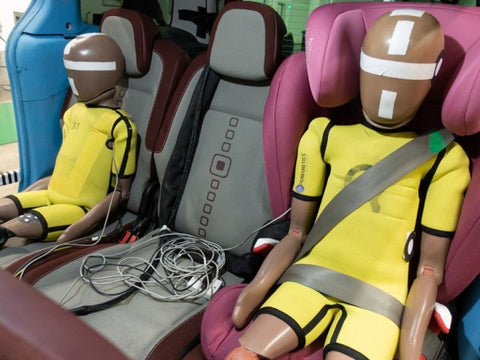When it comes to the safety of our children, car seats play a crucial role in protecting them during an accident. As parents, we trust that car seats will perform well when needed, but have you ever wondered, what speed are car seats crash tested at? Understanding how car seats are tested can provide peace of mind and help you make an informed decision when choosing the right one for your child.
In this blog post, we’ll dive into the world of car seat crash testing, the speeds at which they are tested, the different types of crash tests conducted, and why these tests matter for your child's safety.
Understanding Car Seat Crash Testing
Car seat manufacturers are required to meet strict safety standards before their products can be sold. These standards vary slightly between countries, but most are based on guidelines provided by two major regulations: ECE R44/04 and i-Size (ECE R129) in Europe. Both regulations focus on ensuring car seats can withstand various types of impacts, including frontal, side, and rear collisions.
In these tests, the car seat is installed in a crash simulation vehicle and a test dummy is placed inside the seat to represent a child. Various sensors measure the forces exerted on the dummy during the simulated crash to assess the seat’s ability to protect the child.
At What Speeds Are Car Seats Crash Tested?
In general, car seats are crash tested at speeds that simulate real-world accidents. These speeds vary depending on the type of test and the regulation used, but the most common crash test speeds are:
-
Frontal Impact: Car seats are typically tested at 50 km/h (approximately 31 mph) for frontal impacts. This speed simulates a head-on collision, one of the most common types of car accidents.
-
Rear Impact: Rear collisions are tested at slightly lower speeds, usually around 30 km/h (approximately 18.6 mph). While rear-end accidents are less severe than frontal crashes, it’s still essential for car seats to offer protection during these events.
-
Side Impact: Under the newer i-Size regulations, side-impact tests are conducted at speeds of around 24-30 km/h (approximately 15-19 mph). Side-impact collisions are particularly dangerous for children, as there’s less structural protection on the sides of vehicles.
These speeds are based on typical urban driving conditions, where many accidents occur. While higher speeds are certainly possible in highway crashes, testing at these speeds provides a reliable benchmark for most real-world accident scenarios.
Why Are Car Seats Crash Tested at These Speeds?
You may be wondering why car seats are tested at relatively low speeds compared to the speeds you might drive on highways. The reason is simple: most accidents happen in urban areas, where vehicles are typically traveling between 30-50 km/h. Testing at these speeds simulates the conditions under which the majority of accidents involving children occur.
Additionally, crash tests at these speeds provide valuable data on how car seats perform in terms of deceleration forces, energy absorption, and restraint effectiveness. Higher-speed tests, while possible, would likely destroy the vehicle itself, making it difficult to isolate the car seat’s performance.
The Importance of Side-Impact Testing
While frontal impacts are the most common type of accident, side-impact collisions are particularly dangerous for children. There’s less vehicle structure to absorb the energy of the crash, and the proximity of the child to the door increases the risk of serious injury.
This is where the newer i-Size (ECE R129) regulation shines. Unlike the older ECE R44/04, i-Size requires all car seats to undergo rigorous side-impact testing. This added layer of protection ensures that your child is safer in a wider range of accident scenarios.
During side-impact testing, car seats are tested at speeds of around 24 km/h to simulate a vehicle being hit from the side. Sensors measure the impact forces and check whether the seat effectively protects the child’s head, neck, and torso from injury.
What About Real-World Accidents at Higher Speeds?
While car seats are tested at lower speeds, real-world accidents often occur at higher speeds, especially on highways. Does this mean car seats are less effective in high-speed crashes? Not necessarily.
Car seats are designed to protect your child by distributing crash forces evenly, reducing the risk of injury, and keeping them securely restrained. Even in higher-speed collisions, a properly installed car seat can significantly reduce the risk of serious injury or death. However, it’s always important to follow the manufacturer’s guidelines for weight, height, and installation to ensure the seat performs as intended.
Different Types of Crash Tests for Car Seats
In addition to testing at different speeds, car seats are put through various types of crash tests to assess their overall safety. These include:
-
Frontal Impact Testing: Simulates a head-on collision by launching the test vehicle into a barrier at 50 km/h.
-
Rear Impact Testing: Simulates a rear-end collision, testing how well the car seat absorbs shock and holds the child in place.
-
Side Impact Testing: Simulates a vehicle being hit from the side to ensure the seat provides adequate head and torso protection.
-
Roll-Over Testing (less common): Some manufacturers conduct roll-over tests to assess how well the seat performs during vehicle rollovers, though this is not a requirement in most regulations.
How Do Crash Test Results Affect Car Seat Selection?
Understanding the speeds and types of crashes car seats are tested at can help you make an informed decision when choosing a seat for your child. Look for car seats that comply with the latest regulations, such as i-Size, which offer enhanced protection, particularly in side-impact situations. Additionally, consider seats that have undergone independent consumer testing by organizations like ADAC or Which?, which often conduct more rigorous tests than those required by law.
Conclusion
Car seats are tested at speeds of 30-50 km/h for various types of collisions, simulating the most common accident scenarios in urban driving environments. By choosing a seat that meets the latest i-Size (ECE R129) regulation, you can rest assured that your child will have protection in both frontal and side-impact crashes.
The key takeaway is to always ensure your child’s car seat is installed correctly and meets the latest safety standards. While no car seat can guarantee complete protection in all situations, a well-chosen and properly fitted car seat can make a life-saving difference in the event of an accident.







Comments (0)
There are no comments for this article. Be the first one to leave a message!